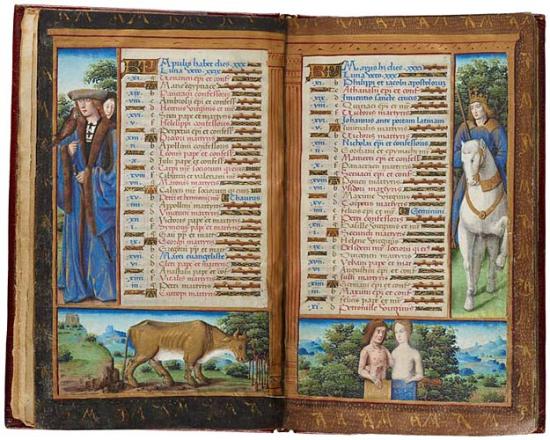
Book of Hours, in Latin
Illuminated by the Master of Petrarch's Triumphs
Purchased by J. P. Morgan, Jr., 1906
As seen elsewhere in this exhibition, medieval calendars can be great sources for representations of contemporaneous clothing. In this prayer book it is the month of April that is illustrated by a fashionably dressed young man with a falcon on his wrist. He wears a very luxurious fur-lined full-length gown with wide lapels and large, open sleeves. His doublet is open at his chest, revealing, below knotted ties, a linen shirt. His wide hat has an upturned brim. Below the man is April's zodiacal sign of Taurus. On the right, May is illustrated by a mounted king and the sign of Gemini.
Twilight of the Middle Ages
This was a period of transition in northern Europe—the Middle Ages were not yet over, and the Renaissance had not yet begun. Both King Charles VIII and Louis XII invaded Italy, and these military campaigns exposed France to Italian art, culture, and fashion. At the same time, the Late Gothic style still dominated the arts—and clothing—of northern Europe. Fashions of this period reflect these conflicts.
In the 1480s, the look for men changed abruptly. Padded shoulders and the V-shaped silhouette disappeared. Long loose open gowns came into style and, by the 1490s, these gowns became especially voluminous and bulky. Round-toed shoes replaced the pointy pouleines. New, however, and probably reflecting Italian influence, were the man's outer coat called a sayon, the man's hat called a carmignolle, and doublets with slit sleeves through which the linen of the shirt protruded.
Women's gowns of this period also became fuller, and bombard sleeves were revived. The neck got square. The turret disappeared, while its frontlet remained, now attached to a new small-crowned coif.
